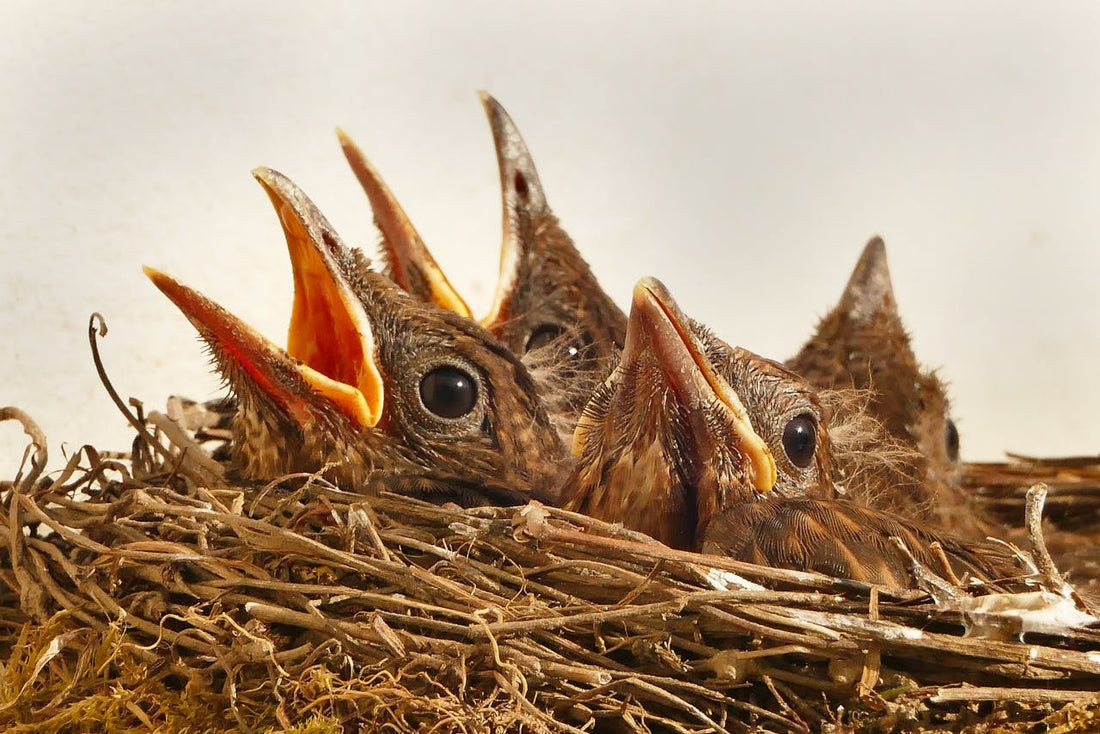
Breeding times of birds: When do our native bird species breed?

Parents and gardening enthusiasts know it: as soon as spring awakens, a flurry of activity begins in the nests in the garden. The breeding season is an exciting and crucial phase in the lives of our native birds - and an opportunity for nature lovers to observe great nature experiences right on their doorstep. But when exactly do which bird species breed and how can we support them during this time? In this blog post, we provide a detailed overview of the breeding seasons of some common garden birds in Germany and show you how to create ideal conditions for these feathered friends in your family garden. You will also learn how a bird house with a camera can provide unique insights into breeding activity - an educational adventure for young and old.
1. early start: When does the breeding season begin?
The start of the breeding season depends on the species and the weather. Some birds start breeding very early, often before spring has even begun on the calendar. Blackbirds and some tits, for example, are among the first native breeders of the year. Blackbirds often start building their nests at the end of February and lay their first eggs in March or April. Robins and wrens are also early starters and can start breeding as early as March. Smaller songbirds such as tits usually wait until April when the temperatures rise and the food supply increases. Overall, the official bird protection and breeding season starts on March 1 - according to the Federal Nature Conservation Act, the protected nesting and breeding period begins on this date and lasts until September 30. During these months, it is even forbidden to radically cut hedges or trees so as not to disturb nesting birds. Garden owners should therefore carry out major pruning before March so that early-breeding species remain undisturbed.
What does the start of breeding depend on? Daylight and temperature are the main factors. A mild spring can cause some birds to start breeding earlier, while a long winter delays the start. So it can vary from year to year. The location also influences the timing: in cities with warmer microclimates, some species start a little earlier than their counterparts in the countryside. Regardless of the exact dates, as soon as the days get longer and the first insects swarm, many birds start their family planning.
2. peak season in spring: overview of breeding times for garden birds
For most native garden birds, the main breeding season is in spring and early summer, roughly between March and June. During this time, the birds lay their eggs, incubate them and raise the young birds. However, the exact breeding times differ significantly depending on the bird species - some start earlier, others later, and the duration of breeding (i.e. the time from egg laying to hatching) can vary from species to species. The following table provides a useful overview of the breeding seasons of some typical garden birds in Germany, their breeding start date, approximate breeding duration, preferred nesting sites and the number of broods per year:
Breeding seasons of typical native garden birds (Germany)
| Bird species | Typical start of breeding | Breeding period (incubation) | Nesting site | Broods per year |
|---|---|---|---|---|
| Great Tit | March | approx. 14 days | Tree hollows, nesting boxes | 1–2 |
| Blue tit | April | approx. 14 days | Tree hollows, nesting boxes | 1–2 |
| Robin | March | 12-15 days | Close to the ground in dense bushes (half-caves) | 2 |
| Blackbird (Black Thrush) | March | 12-14 days | Bushes, trees (open nest) | 2–3 |
| House sparrow (sparrow) | April | 12-14 days | Building recesses, roof boxes | 2–3 |
| Star | March | 11-13 days | Tree holes, nesting boxes (larger hole) | 1–2 |
| Wren | April | 14-18 days | Close to the ground in thickets (ball nest) | 2 |
| Chaffinch | April | 10-16 days | Trees, shrubs (open cup nest) | 2 |
| Redstart | May | approx. 14 days | Tree hollows, wall holes (half-hollow breeders) | 1–2 |
| House martin (house martin) | May | 14-16 days | Clay nests on house wall (under roof) | 1–2 |

Note: The figures are average values. The start and duration of breeding can vary slightly depending on the weather and region. For example, a colder spring can cause breeding to be delayed by a few weeks. There are also variations within a species: Not all individuals start breeding at exactly the same time.
As you can see, many garden birds start breeding in April. In March, the first thrushes (blackbirds, song thrushes) and some cavity-nesting birds such as starlings are particularly active. April to June is the peak period when most songbirds - from tits to sparrows and finches - incubate their eggs. Later in the year (May to July), migratory birds such as the common redstart or house martin, which only start breeding after returning from their wintering grounds, join in. For nature lovers, this means that there is plenty to observe from spring to summer, as eggs are constantly being laid somewhere in the garden, chicks are hatching or young birds are fledging.
Hungry nestlings in spring: young birds like these blackbird chicks wait for food with their beaks wide open. During the main breeding season from April to June, we can witness many such scenes in our gardens. This is the breeding season - the adult birds are constantly flying around with insects and worms to feed their young. For us garden owners, this phase means observing and marveling, but also being considerate (more on this in the following sections).
3. once, twice, three times: how often do birds breed each year?
Not all bird species are content with a single brood per season. Many small birds lay eggs several times a year, which increases their chances of raising enough offspring in terms of evolutionary biology. Several broods in a row are common, especially among common garden birds: sparrows (sparrows) and blackbirds, for example, can raise 2-3 broods per year. With an optimal food supply and mild weather, up to four clutches have even been documented in blackbirds - although three broods is already a lot in the Central European summer. Tits also usually manage two rounds: Once the first brood has successfully fledged in May, a second often follows in June/July. Bird species with a very short breeding and nesting period, such as barn swallows, can even raise three broods a yearprovided there is sufficient food (especially insects) and the weather cooperates.
On the other hand, there are species that only have one brood per year. These are often larger birds or long-distance migrants. Swifts, for example, only return in May and only have one brood in the short summer period. Many birds of prey and owls also only breed once a year. The breeding season therefore varies depending on the species: while the season for sparrows can last from March to Augustswifts or certain songbirds, it is already over in July.
For us gardening enthusiasts, this means constant vigilance. If a nest is empty in June, a new one may well appear elsewhere in July. For this reason, used nests, for example, should not be removed too quickly - some pairs of birds use the same nesting site a second time in summer. The following also applies when cleaning nest boxes: only clean them in the fall or winter when the entire breeding season is really over. This will ensure that no stragglers are disturbed.
4. observe the breeding season - but do it right: experience nature up close

Witnessing the bird breeding season live is an unforgettable experience, especially for children. When peeping chicks hatch in the nesting box or a mother blackbird feeds her young in the dense shrubbery, the garden becomes an open-air classroom. Nevertheless, caution is advised: Observe yes, disturb no.
The most important thing is to observe from a sufficient distance. For example, use binoculars to look into the nest instead of inspecting it up close. Refrain from touching nests or removing young birds - the latter is even prohibited by law. Even if well-intentioned, bird parents know their job best. If children find an apparently abandoned young bird on the ground, explain to them that it does not need to be "rescued" - the parents are usually nearby and will take care of it as soon as the coast is clear. Only in the case of obvious injury or danger (e.g. from cats) should you intervene and contact a bird rescue center.
Modern technology offers a great opportunity to take part in the family life of birds up close and without disturbance. With a nesting box with camera you can look into the nest without disturbing the birds. Such nest boxes equipped with a WLAN camera transmit live images of the nest's interior. This allows you to see in real time how the parent birds incubate eggs, the chicks hatch and are fed. Thanks to advanced systems with motion sensors or even AI-supported bird species recognition, you can also find out which species has just moved in with you. A nesting box with a camera is not only exciting for avid bird fans, but also educationally valuable for children: the little ones learn a lot about nature without disturbing a living creature. It is important to hang up the camera nesting box in winter at the latest so that it is occupied in good time - and to install the cables/technology in such a way that the birds are not disturbed. Then it's time to watch, marvel and share in the excitement as the feathered families grow up.
Finally, an appeal: enjoy the breeding season in your garden to the full, but always with respect for the animals. Every successful bird family in your garden is a small contribution to nature conservation. By making your garden a haven for breeding birds, you are making an important contribution to the conservation of our native birdlife. And by the way, the presence of birds creates a lively, cheerful atmosphere that the whole family can enjoy.
How do you experience the breeding season in your garden? Have you ever watched a pair of birds raising their young - or even built nesting boxes yourself? Please tell us about your experiences and tips!
